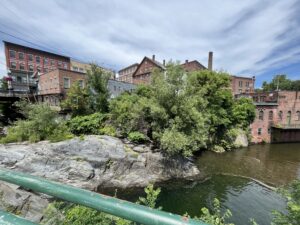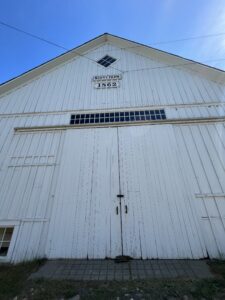Preservation Maryland recently sent Historic Property Redevelopment Manager Laura Houston to Vermont to spend a week with The Landmark Trust USA. Supported by grants from the National Trust for Historic Preservation’s Peter H. Brink Leadership Fund and the Maine Community Foundation’s Keepers Preservation Education Fund, the purpose of the visit was to bring together two preservation organizations with shared emphasis on – and experience in – historic property redevelopment to exchange knowledge and ideas, expand reach and impact, and identify opportunities for potential partnership.
And what a week it proved to be!
As an organization expanding its property redevelopment programming, a central goal for Preservation Maryland has been to build a program that is intentional and effective. One of the ways we are achieving this is by establishing a strong foundation of knowledge that can inform program development, guide project management, and inspire investment in preservation efforts that are inclusive, accessible, and driven by local priorities. This includes learning from those who have expertise in navigating similar situations—those like The Landmark Trust USA!

Brattleboro
Headquartered in the rural town of Dummerston near Brattleboro, Vermont, The Landmark Trust USA is a non-profit established in 1991 that restores at-risk historic properties through creative and sustainable uses for public enjoyment, education, and inspiration. Their properties are made available year-round as short-term vacation rentals and occasionally play host to educational programs and tours led by the organization. The non-profit shares headquarters with Scott Farm, a Certified B Corporation and property of The Landmark Trust USA that has served as a working farm since 1791, and The Stone Trust, a non-profit that endeavors to preserve and advance the art and craft of dry stone walling.
Laura’s education began even before arriving in Vermont. Executive Director Susan McMahon shared a plethora of documentation related to the organization’s history, policy, and strategic planning, as well as property and market studies. Once in the Green Mountain State, The Landmark Trust USA staff and board graciously shared their time and experience with Laura throughout the week, exploring just about every aspect of historic property redevelopment and stewardship, including standard operation, guiding preservation philosophy, benefits and complications of the short-term vacation rental business model, fulfilling a multi-pronged mission, site interpretation, economic impact, fundraising, property maintenance, collaboration with local, state, and national partners, event hosting, and so much more!
The week also included stays in two Landmark Trust properties to better understand how much work goes into caring for and meeting the individual needs of each historical resource. Other activities included tours of additional Landmark Trust properties, which range from a rehabilitated 1915 cabin that formerly housed boilers used for converting raw sap into maple syrup to a ca. 1849 farmhouse to Rudyard Kipling’s Naulakha built in 1892, and more. These site visits put into perspective both the challenging and rewarding aspects of preserving historic properties as vacation rentals and how all the topics discussed were put into practice. Of course, they also provided opportunity to enjoy exquisite architecture, talk history, and take in some stunning views!

Scott Farm
Laura spent time with Scott Farm staff and the Preservation Trust of Vermont as well to learn more about the work they each carry out in fulfilment of their respective missions and was even treated to an evening with preservation pup Maisie, a regular at The Landmark Trust USA office and game for some new company so her human could step away for a meeting. Time also allowed for visits to nearby towns with Susan and conversation about how The Landmark Trust USA works with local residents and businesses to ensure their mission works in support of and is welcomed by communities located around Landmark Trust properties.
Undoubtedly, peer-to-peer learning opportunities such as these have incomparable value and lend themselves to creating a stronger preservation movement. Indeed, the week resulted in stronger bonds between two effective, mission-driven preservation organizations, and plans for collaboration that will enhance both organizations’ abilities to save irreplaceable and endangered historical resources are already in development!
Our sincerest thanks to The Landmark Trust USA for welcoming Preservation Maryland and sharing your expertise and to the National Trust for Historic Preservation and Maine Community Foundation for making the week possible!

